EPISODES
These episode are in no particular order. Please note that, since I don't have scripts in front of me, I'm guessing at some of the characters and place names' spelling. I hope to soon have a bibliography for the series writers)
City at the Edge of Midnight (Michael Reaves & Karl Geurs)
One of my personal favorites, for a variety of reasons. It starts with a seemingly unrelated prologue back in "reality", in a kid's bedroom (complete with a poster reading OLTER SPACE); some force pulls the kid under his own bed, where he vanishes (a bit of a Poltergeist influence). Before the halfway mark, the force also gets Bobby, and the others rescue him and all the other children, enslaved by a demon trying to stop time. One of the enslaved is Ayisha, daughter of Rahmoud, a Douglas Fairbanks swashbuckler type the kids met at a desert oasis; Eric's comment that this character is "better than my dad ever was" hints volumes. Nice twist at the end; they rescue the kid from the prologue, someone they all knew from school, who blithely refuses to believe that the whole thing was anything but a dream.
Day of the Dungeonmaster (Michael Reaves)
It would have been interesting to have given ANY of the kids the absolute power of Dungeonmaster for a day; in a way, giving them to Eric was predictable. Still, he needed to learn the discipline. A good episode, especially in its depiction of DarkHaven, home of the Golden Grimoire, a volume of magic which the kids could use to get home. Pop-culture reference: when Presto pulls an electric fan out of his hat, he quotes Bullwinkle J. Moose.
Child of the Stargazer (Michael Reaves)

Diana gets a love interest, and reveals a bit of her history, in a story noteworthy for emotion and atmosphere. The villain this time is an effective cousin to Two-Face, Queen Sirith of Turadh, trying to block the fulfillment of a prophecy by Kosar, son of an astrologer.
Dragons' Graveyard (Michael Reaves)
A quick-moving episode; before the first two minutes are up, the kids fight off a frost giant and almost reach a portal back to their world, only to see Venger blast it. This sends Hank over the moral edge, as he decides (without saying it in so many words) that they won't be able to leave the Realm until they kill Venger. In pursuit of this goal, which comes in for some moral questions, the kids get their weapons recharged at the graveyard of the title (which also happens to be where the original cavern of Tiamat is located). At its best, D&D mixed action with an emotional subtext usually missing from Saturday morning fare; this episode (with what I call Hank's "samurai eyebrows") is a great example.
Treasure of Tardos (Michael Reaves)
Venger and a bunch of Orc-soldiers are laying siege to Tardos Keep, in order to get dragonbane, which grows nowhere else and which he wishes to use on Tiamat. To break into Tardos, he creates an effective two-headed (fire-breathing, ice-breathing) dragon, in Eric's words, "bigger than my dad's bank account", with a back full of tentacles. When these grab the weapons from our heroes, the dragon becomes a free agent, and Venger and the kids have to join forces to stop it. When it is stopped, Venger proves either too dim to figure out why, or at least chivalric enough to return the favor. Dungeonmaster gets an intriguing curtain-line: "There was good in him once, a long time ago. Everyone makes mistakes; Venger was mine."
Traitor (Jeffrey Scott)

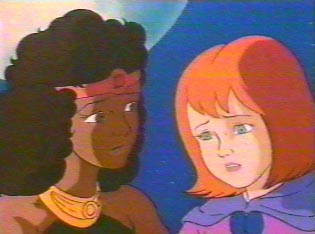
The series is shot through with pop culture references, some more blatant than others. This one is pretty obvious, as the kids help a group of teddy-bear-like creatures who live in tree-cities, and whose most sophisticated weapon is granola (I'm not making this up). Fortunately, these Cloud Bears (read: Ewoks) are not the real focus; as the title suggests, the question is whether Hank is siding with Venger. Check out the opening sequence in the Moon Forest and its creative use of light.
The Last Illusion (Jeffrey Scott)
An interesting episode, not least because Presto gets the girl. And she's not an ordinary girl; Varla is a teenager with the power to cloud men's minds--big time. She can induce mass hallucinations of blight or plenty, fair weather or foul. She's being held prisoner by Venger and forced to create illusions of his choosing. (He hints that she is on the edge of having her powers multiply; sounds like a reference to Carrie). Venger's torture of Varla is psychic/magical, but it does introduce something animated characters seldom feel: agonizing pain. Add the element of mob hysteria when the villagers think the kids caused the disasters, and you've got one of the better scripts.
Night of No Tomorrow (Michael Evanier)

Contrary to every bit of the Arthurian legend, Merlin is presumed (a) to live in a floating castle in the Realm, and/or (b) to have died there a thousand years before the kids get there. None of which has anything to do with Malory, but the kids buy into what they see, trying to get home via Merlin and by visiting the city of Helix, once dragon-infested until Merlin. Tiamat appears in this episode too, which has a lot of action but is a bit light on the richness of character of the series' best work.
The Girl Who Dreamed Tomorrow (Karl Geurs)
Sometimes the networks would hype their Saturday morning line-ups in prime-time on Friday; for its second season, this D&D episode was made the focus of the special. Deservedly so; this episode is a good example of the different direction the series charted, compared to the run-of-the-mill.
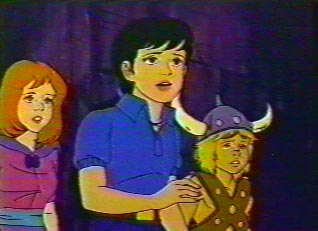 Bobby finds a friend in the title character, who can see in short hops
into the future in her dreams (yet another pop-culture borrowing, in this
case Stephen King's "The Dead Zone"). She got to the Realm with her dog, Freddie, which makes them Freddie and the Dreamer! (It's a bad joke only if you're into Sixties British Invasion rock.) The Maze of Darkness is a great locale,
especially the part that brings out people's dark sides; the expressionistic
style focuses right in on what must be a universal kid anxiety. And while
the 5-headed dragon conjured up by Venger may seem a bit pedestrian next
to Tiamat, the beast blocking the way home is one of the best creations
of the series.
Bobby finds a friend in the title character, who can see in short hops
into the future in her dreams (yet another pop-culture borrowing, in this
case Stephen King's "The Dead Zone"). She got to the Realm with her dog, Freddie, which makes them Freddie and the Dreamer! (It's a bad joke only if you're into Sixties British Invasion rock.) The Maze of Darkness is a great locale,
especially the part that brings out people's dark sides; the expressionistic
style focuses right in on what must be a universal kid anxiety. And while
the 5-headed dragon conjured up by Venger may seem a bit pedestrian next
to Tiamat, the beast blocking the way home is one of the best creations
of the series.
Hall of Bones (Paul Dini)

A mostly-adventure episode, with the bad guys looking pretty grim. The kids start out attacked by simian bats (these flying monkeys are SERIOUS), only to have their weapons go out on them. They go to a town that looks like a Renaissance Faire, Eric does some bad stand-up comedy, they run into a truly impressive Demon-Queen of Spiders, and ultimately get to the Hall of the title, repository of the Realm's heroes (if you watch for such things, it's nice to note that some women warriors are also buried there). Pop-culture borrowing: Hector the Halfling, a cross between a hobbit and a Cheshire cat. Animation glitch: when DM appears, he's greeted by Hank's voice, but it's Eric's mouth that moves.
In Search of Dungeonmaster (Jeffrey Scott)
This is the only episode marketed onto cassette. Presumably it was the pilot; at least it sounds most of the action/adventure themes, and seems to go out of its way to introduce characters and traits. The kids have to cope with about three episodes' worth of bad guys, including Warduke, a fairly impressive Conan-style bounty hunter. Eric runs into a really grim swamp zombie. The hint at the end--that DM let himself be put on ice so that the kids could shut down the slave-mines of Baramor--still begs the question of why the kids had to do it. Still, it established Dungeonmaster as all-powerful but detatched. Sheila is shown as able to understand gibberish-sounding fairy-speech; no explanation, and it doesn't happen anywhere else in the series. Decent enough script, but (my bias) the show really got good when the action was subordinated to the characters' emotional lives.
Valley of the Unicorns (Paul Dini and Karl Geurs)

Venger has an ally in Kelek, whose trained wolves help him round up all the unicorns in the Realm to steal their horns. Uni gets caught and de-horned, and the kids have to rely on Venger for help; not the wisest move. Some good use of light effects. Best moment: when Venger confronts Kelek, Bobby reverts to kid: "SOME-body's GET-tin' in TROUB-le."
The Garden of Zinn (Jeffrey Scott)
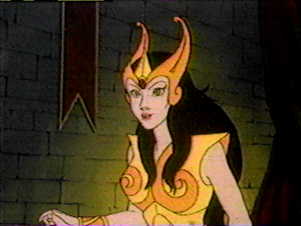
No Venger this time, and not as much emotional exercise as there could have been. Bobby gets nipped by a dragon, and the only cure is in the garden of the Queen of Zinn. Her Stalkers are more impressive than she is, although her retro-fantasy brass bikini recalls Leia in Return of the Jedi. The key is Shiela's compassion toward Sorlarz, a horse-faced hermit creature. Interesting hint: on top of gymnastics, Diana, when confronted by a giant worm (shades of Dune?), wonders aloud if a worm can be saddlebroken and immediately mounts it. Once they break the surface, she tells the others when to jump. So is Diana also an equestrian?
Servant of Evil (Jeffrey Scott)
This one takes place in one of the series's better locales, the Prison of Agony, built on a mountain suspended on giant chains over an active volcano. The giant Karox unwillingly runs the place for Venger. This episode takes place on Bobby's birthday; how did the kids reckon time? According to "City at the Edge of Midnight", time may be standing still in our world while the kids are in the Realm. Venger's 2-headed lava dragon is a great, if vulnerable, menace.
This episode has no less than three indications that the series went through Japanese hands: (1) the sequence with Presto and the firehose; (2) some of the critters who escape the Prison of Agony have a Japanese look to them. But the main indication (3): Strongheart had been tunnelling through the wall, and had hidden the tunnel behind a giant barrel. On the barrel is clearly written (twice) "Santory 1865". This is a play on Suntory, a major Japanese brewer and distiller.
Eye of the Beholder (Hank Saroyan; Story by Mark Evanier and Kimmer Ringwald)
Through an odd chain of circumstances a cowardly knight proves himself brave. This one is a lesser episode for me because of (a) the flower being too gimmicky, and (b) Sir John seeming like such a retread from "The Reluctant Dragon". Again, there's creative lighting in the mushroom forest sequence. When Venger is zapped out of the scene at the end, it's an open question who did it. It wasn't Hank; the shot came from the wrong angle, and was a red bolt of energy. Each of the kids' weapons has a distinctive color, and none is red. Are we to assume it was Dungeonmaster?
The Box (Jeffrey Scott)
Occasionally surreal backgrounds and a character who looks like Dungeonmaster's kid sister are the focus here. The title box is a bottomless trunk that connects different dimensions. If you have a copy of this, slo-mo and freeze-frame the sequence where, falling into the wasps' nest, Hank plucks Sheila out of midair. The change of expression on her face is proof: somebody finally cared about good Saturday-morning animation with this series. And, to top it all, not only do the kids get back to Earth, but so does Venger! (While they were back, Presto has a throwaway line that may be the name of the amusement park: "When in Loonyland, do as the loonies do.")
Quest of the Skeleton Warrior (Buzz Dixon)
Definitely one of the better episodes, in no small part because of the title warrior: Dekion, a living skeleton with one eye left; this had to be one of the grimmest characters ever on Saturday morning. The kids have to enter the tower of the Celestial Knights, in which their own fears are turned against them. If this wasn't limited to a single half-hour, the script could have been amazing in plumbing the depths of the heroes. It wraps up a little too soon, but before it does the sight of Sheila in a Salvador Dali wasteland or Diana as an octagenarian is very well done. Actually, the visuals here are top-quality beginning to end. Again, a pop-culture reference from Presto; he starts a spell "Sim sim sala--" but doesn't finish it; just as well. "Sim sim sala-bim" was the favorite incantation of Jonny Quest's bud Hadji. This is the second time Presto has quoted another 'toon!
Prison Without Walls (Steve Gerber)


Certainly one of the busiest episodes of the bunch. The Realm happens to be a planet with multiple moons orbiting multiple suns, but this is the only episode that uses this fact in the plot. Quite a lot happens to the gang on their way to freeing Lukion the Spellbinder from Venger's enchantment (the House of Zombies they encounter looks great), but when Lukion faces off against Venger, everything breaks out--even a second chance for Uni to use her limited powers (see "Valley of the Unicorns"). One sequence tossed in by the animators for the heck of it: when the giant statues are demolishing the gnomes' huts, one family flees their home; the child stops, turns to look and has to be dragged away.
Cave of the Fairie Dragons (Kathy Selbert)
The good news is that a character in the Realm gets a crush on Presto; the bad news is, it's Amber, a dragon about the size of a housecat. There's a whole race of mini-dragons, whose captured queen Tasmira (and hunted-for treasure) have to be rescued by the kids from King Varen. (Writer Selbert took the liberty of bringing to the Realm the dragon characters she had created elsewhere. It's been done before; remember the animated Star Trek series, when Larry Niven brought in his Gzinti?) The dragonettes escape to their forest lair through a mirror, which the kids could also use to get back to the amusement park. (Note the glitch in this episode: when Queen Tasmira escapes, the mirror is showing the amusement park, not the forest). The pop-culture nod this time around is when Presto names a certain 50s movie about giant ants.
P-R-E-S-T-O Spells Disaster (Jeffrey Scott)
The six start out running from a stegosaurus (correct me if I'm wrong, but weren't they vegetarian?) into a platoon of Orcs, from which Presto zaps all but himself and Uni into a high-rise castle. (Of all the pop-culture borrowings, this retread of "Jack and the Beanstalk" is pretty lame, not least because the giant speaks with a Brooklyn accent(!)) Presto plays a shell game with skulls. Some of the visuals are pretty impressive. The plot turns on an endangered species of dragon; this episode is Venger-free.
The Lost Children (Jeffrey Scott)
One of the weaker episodes, for several reasons. Borrowing from pop culture is nothing new for this series, but when they go out of their way to name the connection, you know it's not good. When the kids run into a group of children (painted up to look like something from "Lord of the Flies" but speaking impeccable English) and rescue their large, werewolf-looking but technologically savvy elder Alcor from Venger, did Eric have to refer to Alcor as a "wookie"? The story barely works as glue to hold together the action sequences.
Pop-Culture Reference #1: Alfor has to fix the "motivator device" on his ship; Luke Skywalker and his uncle almost buy the wrong R2 unit, but the one they choose first breaks down at once because of a "bad motivator". Pop-Culture Reference #2: while fixing the ship, Alfor asks for a "Krel wrench", invoking the extinct Krel civilization beneath the Forbidden Planet, a true 50s sci-fi classic.
Dungeon at the Heart of Dawn (Michael Reaves)
Reaves mashes two scripts together, apparently, with interesting consequences. The opening scene is not so unusual; the kids invade the Tower of Darkness to get the Box of Balefire; Eric peeks into the box, and the action breaks open. What comes to lay waste to the Realm seems closer to one of the Old Gods from an H. P. Lovecraft story; it's all DM and the kids can do to survive it. Having to recharge their batteries involves a pilgrimage to the Heart of Dawn, a subterranean pool. Losing the kids one by one along the way is a good device. Certainly a daring move for a cartoon was playing the first twenty seconds in total darkness.
The Time Lost (Michael Reaves)
Venger takes a different approach to getting rid of the meddling kids: he will change history by making sure the Nazis win World War II, causing the kids never to have been born. To this end he brings to the Realm a 1990s fighter jet (whose pilot describes Venger as "some guy in a dress"!) and Josef Mueller, an ace from the Luftwaffe.
By the way, Mary Robbins recently purchased a copy of the storyboard for this episode, which shows not only a swastika on Josef's plane, but the fact that his name was Josef Wulf! Plus a few details about the failure to get through the portal in the Castle of Clouds. See the storyboard at: hcgl.eng.ohio-state.edu/~robbins/DDstoryboard.html.
This posed an interesting dilemma for CBS Standards & Practices: depicting a story in which the Nazis might have won the war without using the words "Nazi" or "Hitler" or showing a swastika. The results, while satisfying, are vague, and may only confuse modern kids who don't know the history. They may not know whether references to "the tyrant who caused [this war]" mean Adolf Hitler or Richard Nixon. Nonetheless, a fine series entry, and we find out (in a throwaway line) that Diana has a brother.
Odyssey of the 12th Talisman (Mark Shiney & Michael L. DePatie)
Again, not the most thought-through episode of the bunch, but it has its points. The main one is that Eric finds a kindred spirit in Lorn, an orphaned drifter who possesses the talisman of the title; powerful, but full of bad luck. He's chased by a wizard named Korlok (but we don't learn his name until the last 2 minutes) and as for what happens to Korlok in the final scene, maybe somebody can e-mail me with their speculations, because the script is absolutely no help. The herd of camel-dragons at the beginning is pretty impressive, and there's an indication that Diana believed in Eric's ability to come up with a plan when no one else would believe it, but that's about it.
Beauty and the Bogbeast (Jeffrey Scott)
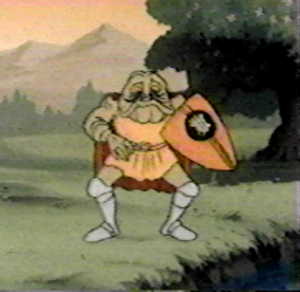
The kids actually get home at the end of this one, if temporarily. Eric spends most of the episode looking like one of the frog-faced Bogbeasts, who are being harrassed by the giant Cawamung. Bobby and Hank have to deal with a giant statue that looks like a Roman warrior but calls itself Golem. This would have been a lot better if the Bogbeasts didn't speak the monosyllabic English usually reserved for 1940s Hollywood Indians.
Citadel of Shadow (Kathy Selbert)
This is one of the more interesting episodes, if only because of the real identity of Karina, a blonde young girl placed under a spell. Not to spoil anything, but, when Shiela breaks the spell and sets everything in motion, notice that Karina's shadow has sprouted batwings. The best line in the episode, possibly the best in the series, could only have been written by a woman: Eric has been riding Shiela for her supposed incompetence, causing Diana to deliver an incredible gender-bender put-down: "He's just having one of his days, Shiela; ignore him." Safe to say that went right over the heads of most of the kids watching.
Winds of Darkness (Michael Casslitt & Kathy Selbert; Story by Karl Geurs)
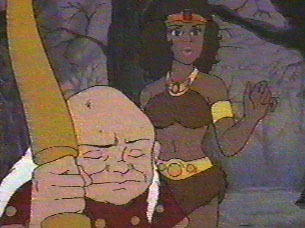
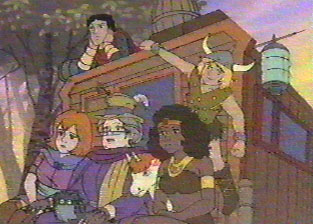
Maybe this is a case of "too many cooks", but a backstory that's never properly developed keeps a good script from being a great one. The villain is still impressive: a scary looking wraith with a fog that absorbs its victims out of existence. We get a hint that the husband and child of Martha, a little old lady (Angela Lansbury-type) who must keep up her end of a prophecy, were victims. In any case, she's ostracized and very reluctant to help the kids when the fog gets Hank.
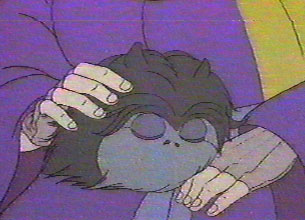 (Another pop-culture
footnote: Martha's furball pet Wiccan has nothing to do with witchcraft,
but does bear a resemblance to Fizzgig, a similar critter in Jim Henson's
magnificant fantasy "The Dark Crystal").
(Another pop-culture
footnote: Martha's furball pet Wiccan has nothing to do with witchcraft,
but does bear a resemblance to Fizzgig, a similar critter in Jim Henson's
magnificant fantasy "The Dark Crystal").